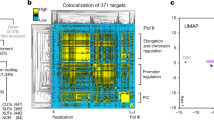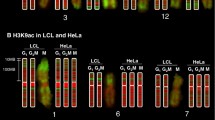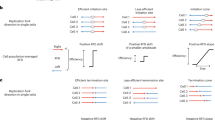Abstract
Elucidating the mechanisms underlying chromatin maintenance upon genome replication is critical for the understanding of how gene expression programs and cell identity are preserved across cell divisions. Here, we describe two recently developed techniques, chromatin occupancy after replication (ChOR)-seq and sister chromatids after replication (SCAR)-seq, that profile chromatin occupancy on newly replicated DNA in mammalian cells in 5 d of bench work. Both techniques share a common strategy that includes pulse labeling of newly synthesized DNA and chromatin immunoprecipitation (ChIP), followed by purification and high-throughput sequencing. Whereas ChOR-seq quantitatively profiles the post-replicative abundance of histone modifications and chromatin-associated proteins, SCAR-seq distinguishes chromatin occupancy between nascent sister chromatids. Together, these two complementary techniques have unraveled key mechanisms controlling the inheritance of modified histones during replication and revealed locus-specific dynamics of histone modifications across the cell cycle. Here, we provide the experimental protocols and bioinformatic pipelines for these methods.
This is a preview of subscription content, access via your institution
Access options
Access Nature and 54 other Nature Portfolio journals
Get Nature+, our best-value online-access subscription
$29.99 / 30 days
cancel any time
Subscribe to this journal
Receive 12 print issues and online access
$259.00 per year
only $21.58 per issue
Buy this article
- Purchase on Springer Link
- Instant access to full article PDF
Prices may be subject to local taxes which are calculated during checkout



Similar content being viewed by others
Data availability
Published available sequencing raw and processed datasets analyzed in this work are available in GSE110354 for ChOR-seq and GSE117274 for SCAR-seq. Data analyzed in Fig. 3a,b correspond to GSM2988387, GSM2988389 and GSM2988390 from ref. 15. Data shown in Fig. 3c are GSM3290321, GSM3290334, GSM3290324, GSM3290344 and GSM3290342. Data used in Fig. 3d correspond to the average signal of all replicates described in ref. 11.
Code availability
Code used to analyze SCAR-seq data is available at https://zenodo.org/record/4719235#.YN5p0BNucdU (GitHub: https://github.com/anderssonlab/Replication_SCARseq, release v1.0.0).
References
Zhou, K., Gaullier, G. & Luger, K. Nucleosome structure and dynamics are coming of age. Nat. Struct. Mol. Biol. 26, 3–13 (2019).
Martire, S. & Banaszynski, L. A. The roles of histone variants in fine-tuning chromatin organization and function. Nat. Rev. Mol. Cell Biol. 21, 522–541 (2020).
Allis, C. D. & Jenuwein, T. The molecular hallmarks of epigenetic control. Nat. Rev. Genet. 17, 487–500 (2016).
Stillman, B. Histone modifications: insights into their influence on gene expression. Cell 175, 6–9 (2018).
Annunziato, A. T. Assembling chromatin: the long and winding road. Biochim. Biophys. Acta 1819, 196–210 (2013).
Annunziato, A. T. The fork in the road: histone partitioning during DNA replication. Genes 6, 353–371 (2015).
Stewart-Morgan, K. R., Petryk, N. & Groth, A. Chromatin replication and epigenetic cell memory. Nat. Cell Biol. 22, 361–371 (2020).
Scharf, A. N., Barth, T. K. & Imhof, A. Establishment of histone modifications after chromatin assembly. Nucleic Acids Res. 37, 5032–5040 (2009).
Alabert, C. et al. Two distinct modes for propagation of histone PTMs across the cell cycle. Genes Dev. 29, 585–590 (2015).
Yu, C. et al. A mechanism for preventing asymmetric histone segregation onto replicating DNA strands. Science 361, 1386–1389 (2018).
Petryk, N. et al. MCM2 promotes symmetric inheritance of modified histones during DNA replication. Science 361, 1389–1392 (2018).
Gan, H. et al. The Mcm2-Ctf4-Polα axis facilitates parental histone H3-H4 transfer to lagging strands. Mol. Cell 72, 140–151.e3 (2018).
Li, Z. et al. DNA polymerase alpha interacts with H3-H4 and facilitates the transfer of parental histones to lagging strands. Sci. Adv. 6, eabb5820 (2020).
Alabert, C. et al. Domain model explains propagation dynamics and stability of histone H3K27 and H3K36 methylation landscapes. Cell Rep. 30, 1223–1234.e8 (2020).
Reveron-Gomez, N. et al. Accurate recycling of parental histones reproduces the histone modification landscape during DNA replication. Mol. Cell 72, 239–249.e5 (2018).
Stewart-Morgan, K. R., Reveron-Gomez, N. & Groth, A. Transcription restart establishes chromatin accessibility after DNA replication. Mol. Cell 75, 284–297.e6 (2019).
Sirbu, B. M. et al. Analysis of protein dynamics at active, stalled, and collapsed replication forks. Genes Dev. 25, 1320–1327 (2011).
Dungrawala, H. & Cortez, D. Purification of proteins on newly synthesized DNA using iPOND. Methods Mol. Biol. 1228, 123–131 (2015).
Alabert, C. et al. Nascent chromatin capture proteomics determines chromatin dynamics during DNA replication and identifies unknown fork components. Nat. Cell Biol. 16, 281–293 (2014).
Salic, A. & Mitchison, T. J. A chemical method for fast and sensitive detection of DNA synthesis in vivo. Proc. Natl Acad. Sci. USA 105, 2415–2420 (2008).
Presolski, S. I., Hong, V. P. & Finn, M. G. Copper-catalyzed azide-alkyne click chemistry for bioconjugation. Curr. Protoc. Chem. Biol. 3, 153–162 (2011).
Rostovtsev, V. V., Green, L. G., Fokin, V. V. & Sharpless, K. B. A stepwise huisgen cycloaddition process: copper(I)-catalyzed regioselective “ligation” of azides and terminal alkynes. Angew. Chem. Int. Ed. Engl. 41, 2596–2599 (2002).
Tornoe, C. W., Christensen, C. & Meldal, M. Peptidotriazoles on solid phase: [1,2,3]-triazoles by regiospecific copper(i)-catalyzed 1,3-dipolar cycloadditions of terminal alkynes to azides. J. Org. Chem. 67, 3057–3064 (2002).
Jakobsen, J. S. et al. Temporal mapping of CEBPA and CEBPB binding during liver regeneration reveals dynamic occupancy and specific regulatory codes for homeostatic and cell cycle gene batteries. Genome Res. 23, 592–603 (2013).
Orlando, D. A. et al. Quantitative ChIP-Seq normalization reveals global modulation of the epigenome. Cell Rep. 9, 1163–1170 (2014).
Fursova, N. A. et al. Synergy between variant PRC1 complexes defines polycomb-mediated gene repression. Mol. Cell 74, 1020–1036.e8 (2019).
Tseng, Z., Wu, T., Liu, Y., Zhong, M. & Xiao, A. Using native chromatin immunoprecipitation to interrogate histone variant protein deposition in embryonic stem cells. in Cancer Genomics and Proteomics (ed. Narendra, W.) 11–22 (Springer, 2014).
Brind’Amour, J. et al. An ultra-low-input native ChIP-seq protocol for genome-wide profiling of rare cell populations. Nat. Commun. 6, 6033 (2015).
O’Neill, L. P. & Turner, B. M. Immunoprecipitation of native chromatin: NChIP. Methods 31, 76–82 (2003).
Petryk, N. et al. Replication landscape of the human genome. Nat. Commun. 7, 10208 (2016).
Lieberman-Aiden, E. et al. Comprehensive mapping of long-range interactions reveals folding principles of the human genome. Science 326, 289–293 (2009).
Bonev, B. et al. Multiscale 3D genome rewiring during mouse neural development. Cell 171, 557–572 (2017).
Buratowski, S. Progression through the RNA polymerase II CTD cycle. Mol. Cell 36, 541–546 (2009).
Xu, C. & Corces, V. G. Genome-wide mapping of protein-DNA interactions on nascent chromatin. Methods Mol. Biol. 1766, 231–238 (2018).
Xu, C. & Corces, V. G. Nascent DNA methylome mapping reveals inheritance of hemimethylation at CTCF/cohesin sites. Science 359, 1166–1170 (2018).
Yu, C. et al. Strand-specific analysis shows protein binding at replication forks and PCNA unloading from lagging strands when forks stall. Mol. Cell 56, 551–563 (2014).
Kaya-Okur, H. S. et al. CUT&Tag for efficient epigenomic profiling of small samples and single cells. Nat. Commun. 10, 1930 (2019).
Kaya-Okur, H. S., Janssens, D. H., Henikoff, J. G., Ahmad, K. & Henikoff, S. Efficient low-cost chromatin profiling with CUT&Tag. Nat. Protoc. 15, 3264–3283 (2020).
Carter, B. et al. Mapping histone modifications in low cell number and single cells using antibody-guided chromatin tagmentation (ACT-seq). Nat. Commun. 10, 3747 (2019).
Harada, A. et al. A chromatin integration labelling method enables epigenomic profiling with lower input. Nat. Cell Biol. 21, 287–296 (2019).
Wang, Q. et al. CoBATCH for high-throughput single-cell epigenomic profiling. Mol. Cell 76, 206–216.e7 (2019).
Adey, A. & Shendure, J. Ultra-low-input, tagmentation-based whole-genome bisulfite sequencing. Genome Res. 22, 1139–1143 (2012).
Wang, Q. et al. Tagmentation-based whole-genome bisulfite sequencing. Nat. Protoc. 8, 2022–2032 (2013).
Xu, M., Wang, W., Chen, S. & Zhu, B. A model for mitotic inheritance of histone lysine methylation. EMBO Rep. 13, 60–67 (2011).
Sobel, R. E., Cook, R. G., Perry, C. A., Annunziato, A. T. & Allis, C. D. Conservation of deposition-related acetylation sites in newly synthesized histones H3 and H4. Proc. Natl Acad. Sci. USA 92, 1237–1241 (1995).
Loyola, A., Bonaldi, T., Roche, D., Imhof, A. & Almouzni, G. PTMs on H3 variants before chromatin assembly potentiate their final epigenetic state. Mol. Cell 24, 309–316 (2006).
Jasencakova, Z. et al. Replication stress interferes with histone recycling and predeposition marking of new histones. Mol. Cell 37, 736–743 (2010).
Parthun, M. R. Histone acetyltransferase 1: more than just an enzyme? Biochim. Biophys. Acta 1819, 256–263 (2012).
Saredi, G. et al. H4K20me0 marks post-replicative chromatin and recruits the TONSL-MMS22L DNA repair complex. Nature 534, 714–718 (2016).
Rice, J. C. et al. Mitotic-specific methylation of histone H4 Lys 20 follows increased PR-Set7 expression and its localization to mitotic chromosomes. Genes Dev. 16, 2225–2230 (2002).
Pesavento, J. J., Bullock, C. R., LeDuc, R. D., Mizzen, C. A. & Kelleher, N. L. Combinatorial modification of human histone H4 quantitated by two-dimensional liquid chromatography coupled with top down mass spectrometry. J. Biol. Chem. 283, 14927–14937 (2008).
Jasencakova, Z. & Groth, A. Restoring chromatin after replication: how new and old histone marks come together. Semin. Cell Dev. Biol. 21, 231–237 (2010).
Bar-Ziv, R., Voichek, Y. & Barkai, N. Chromatin dynamics during DNA replication. Genome Res. 26, 1245–1256 (2016).
Vasseur, P. et al. Dynamics of nucleosome positioning maturation following genomic replication. Cell Rep. 16, 2651–2665 (2016).
Fennessy, R. T. & Owen-Hughes, T. Establishment of a promoter-based chromatin architecture on recently replicated DNA can accommodate variable inter-nucleosome spacing. Nucleic Acids Res. 44, 7189–7203 (2016).
Gutiérrez, M. P., MacAlpine, H. K. & MacAlpine, D. M. Nascent chromatin occupancy profiling reveals locus- and factor-specific chromatin maturation dynamics behind the DNA replication fork. Genome Res. 29, 1123–1133 (2019).
Ramachandran, S. & Henikoff, S. Transcriptional regulators compete with nucleosomes post-replication. Cell 165, 580–592 (2016).
Julienne, H., Zoufir, A., Audit, B. & Arneodo, A. Human genome replication proceeds through four chromatin states. PLoS Comput. Biol. 9, e1003233 (2013).
Grzybowski, A. T., Chen, Z. & Ruthenburg, A. J. Calibrating ChIP-Seq with nucleosomal internal standards to measure histone modification density genome wide. Mol. Cell 58, 886–899 (2015).
Minnoye, L. et al. Chromatin accessibility profiling methods. Nat. Rev. Methods Primers 1, 10 (2021).
Klein, D. C. & Hainer, S. J. Genomic methods in profiling DNA accessibility and factor localization. Chromosome Res. 28, 69–85 (2020).
Uttamapinant, C. et al. Fast, cell-compatible click chemistry with copper-chelating azides for biomolecular labeling. Angew. Chem. Int. Ed. Engl. 51, 5852–5856 (2012).
Leach, T. J. et al. Histone H2A.Z is widely but nonrandomly distributed in chromosomes of Drosophila melanogaster. J. Biol. Chem. 275, 23267–23272 (2000).
Landt, S. G. et al. ChIP-seq guidelines and practices of the ENCODE and modENCODE consortia. Genome Res. 22, 1813–1831 (2012).
Behringer, R., Gertsenstein, M., Nagy, K. V. & Nagy, A. Testing serum batches for mouse embryonic stem cell culture. Cold Spring Harb. Protoc. 2017, pdb.prot092411 (2017).
Green, M. R. & Sambrook, J. Molecular Cloning: A Laboratory Manual 4th edn (Cold Spring Harbor Laboratory Press, 2012).
Luhur, A., Klueg, K. M., Roberts, J. & Zelhof, A. C. Thawing, culturing, and cryopreserving Drosophila cell lines. J. Vis. Exp. https://doi.org/10.3791/59459 (2019).
Afgan, E. et al. The Galaxy platform for accessible, reproducible and collaborative biomedical analyses: 2018 update. Nucleic Acids Res. 46, W537–W544 (2018).
Langmead, B., Trapnell, C., Pop, M. & Salzberg, S. L. Ultrafast and memory-efficient alignment of short DNA sequences to the human genome. Genome Biol. 10, R25 (2009).
Li, H. et al. The Sequence Alignment/Map format and SAMtools. Bioinformatics 25, 2078–2079 (2009).
Quinlan, A. R. & Hall, I. M. BEDTools: a flexible suite of utilities for comparing genomic features. Bioinformatics 26, 841–842 (2010).
Zhang, Y. et al. Model-based analysis of ChIP-Seq (MACS). Genome Biol. 9, R137 (2008).
Ying, Q. L. et al. The ground state of embryonic stem cell self-renewal. Nature 453, 519–523 (2008).
Amemiya, H. M., Kundaje, A. & Boyle, A. P. The ENCODE blacklist: identification of problematic regions of the genome. Sci. Rep. 9, 9354 (2019).
Huang, H. et al. A unique binding mode enables MCM2 to chaperone histones H3-H4 at replication forks. Nat. Struct. Mol. Biol. 22, 618–626 (2015).
Richet, N. et al. Structural insight into how the human helicase subunit MCM2 may act as a histone chaperone together with ASF1 at the replication fork. Nucleic Acids Res. 43, 1905–1917 (2015).
Acknowledgements
We are grateful to K. Stewart-Morgan, A. Wenger, S. Graziano and V. Flury for the critical reading of the manuscript. Research in the Groth laboratory was supported by the Independent Research Fund Denmark (7016-00042B and 4092-00404), the European Research Council (CoG no. 724436) and the Lundbeck Foundation (R198-2015-269 and R165-2013-15306). Research at CPR is supported by the Novo Nordisk Foundation (NNF14CC0001). N.P. is supported by LabEx ‘Who Am I?’ #ANR-11-LABX-0071 and the Université de Paris IdEx #ANR-18-IDEX-0001 funded by the French Government through its ‘Investments for the Future’ program and by an INTEGER grant from Agence Nationale de la Recherche (ANR-19-CE12-0030-01). C.G.-A. is the recipient of a Ramón y Cajal Contract RYC2018-025485-I, and her laboratory is supported by grants PID2019-105742GA-100 from the Spanish Government and VIPPIT-2019-IV.2 from the University of Sevilla. M.D. and R.A. were supported by the Independent Research Fund Denmark (6108-00038B) and the European Research Council (StG no. 638173) awarded to R.A.
Author information
Authors and Affiliations
Contributions
C.G.-A., N.R-G. and A.G. conceived the ChOR-seq project. C.G.-A. and N.R-G. developed the ChOR-seq method with input from N.P. and supervision from A.G. C.G.-A. and N.R-G. built the ChOR-seq analysis pipeline. N.P. and A.G. conceived the SCAR-seq project. N.P. developed the SCAR-seq method with supervision from A.G. M.D. built the SCAR-seq analysis pipeline, with support from N.P. and supervision from R.A. N.P., N.R.-G. and C.G.-A. wrote the manuscript with input from all authors.
Corresponding author
Ethics declarations
Competing interests
A.G. is co-inventor on a patent covering the therapeutic targeting of Tonsoku-like protein (TONSL) for cancer therapy. A.G. is a co-founder and chief strategy officer of Ankrin Therapeutics.
Additional information
Peer review information Nature Protocols thanks Frederic Berger, Angelika Feldmann, Robert Klose, and the other, anonymous, reviewer(s) for their contribution to the peer review of this work.
Publisher’s note Springer Nature remains neutral with regard to jurisdictional claims in published maps and institutional affiliations.
Related links
Key references using this protocol
Reveron-Gomez, N. et al. Mol. Cell 72, 239–249.e5 (2018): https://doi.org/10.1016/j.molcel.2018.08.010
Petryk, N. et al. Science 361, 1389–1392 (2018): https://doi.org/10.1126/science.aau0294
Stewart-Morgan, K. et al. Mol. Cell 75, 284–297.e6 (2019): https://doi.org/10.1016/j.molcel.2019.04.033
Supplementary information
Supplementary Information
Supplementary Methods and Supplementary Table 1.
Rights and permissions
About this article
Cite this article
Petryk, N., Reverón-Gómez, N., González-Aguilera, C. et al. Genome-wide and sister chromatid-resolved profiling of protein occupancy in replicated chromatin with ChOR-seq and SCAR-seq. Nat Protoc 16, 4446–4493 (2021). https://doi.org/10.1038/s41596-021-00585-3
Received:
Accepted:
Published:
Issue Date:
DOI: https://doi.org/10.1038/s41596-021-00585-3
This article is cited by
-
Histone H1 facilitates restoration of H3K27me3 during DNA replication by chromatin compaction
Nature Communications (2023)
-
Symmetric inheritance of parental histones governs epigenome maintenance and embryonic stem cell identity
Nature Genetics (2023)
Comments
By submitting a comment you agree to abide by our Terms and Community Guidelines. If you find something abusive or that does not comply with our terms or guidelines please flag it as inappropriate.



